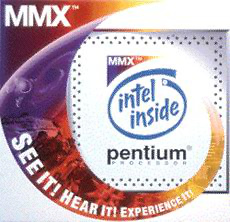
x86 is a family of complex instruction set computer (CISC) instruction set architectures initially developed by Intel based on the Intel 8086 microprocessor and its 8088 variant. The 8086 was introduced in 1978 as a fully 16-bit extension of Intel's 8-bit 8080 microprocessor, with memory segmentation as a solution for addressing more memory than can be covered by a plain 16-bit address. The term "x86" came into being because the names of several successors to Intel's 8086 processor end in "86", including the 80186, 80286, 80386 and 80486 processors.

MMX is a single instruction, multiple data (SIMD) instruction set architecture designed by Intel, introduced on January 8, 1997 with its Pentium P5 (microarchitecture) based line of microprocessors, named "Pentium with MMX Technology". It developed out of a similar unit introduced on the Intel i860, and earlier the Intel i750 video pixel processor. MMX is a processor supplementary capability that is supported on IA-32 processors by Intel and other vendors as of 1997.
In computing, Streaming SIMD Extensions (SSE) is a single instruction, multiple data (SIMD) instruction set extension to the x86 architecture, designed by Intel and introduced in 1999 in their Pentium III series of central processing units (CPUs) shortly after the appearance of Advanced Micro Devices (AMD's) 3DNow!. SSE contains 70 new instructions, most of which work on single precision floating-point data. SIMD instructions can greatly increase performance when exactly the same operations are to be performed on multiple data objects. Typical applications are digital signal processing and graphics processing.
3DNow! is a deprecated extension to the x86 instruction set developed by Advanced Micro Devices (AMD). It adds single instruction multiple data (SIMD) instructions to the base x86 instruction set, enabling it to perform vector processing of floating-point vector operations using vector registers, which improves the performance of many graphics-intensive applications. The first microprocessor to implement 3DNow! was the AMD K6-2, which was introduced in 1998. When the application was appropriate, this raised the speed by about 2–4 times.
SSE2 is one of the Intel SIMD processor supplementary instruction sets first introduced by Intel with the initial version of the Pentium 4 in 2000. It extends the earlier SSE instruction set, and is intended to fully replace MMX. Intel extended SSE2 to create SSE3 in 2004. SSE2 added 144 new instructions to SSE, which has 70 instructions. Competing chip-maker AMD added support for SSE2 with the introduction of their Opteron and Athlon 64 ranges of AMD64 64-bit CPUs in 2003.
In computing, especially digital signal processing, the multiply–accumulate (MAC) or multiply-add (MAD) operation is a common step that computes the product of two numbers and adds that product to an accumulator. The hardware unit that performs the operation is known as a multiplier–accumulator ; the operation itself is also often called a MAC or a MAD operation. The MAC operation modifies an accumulator a:
Supplemental Streaming SIMD Extensions 3 is a SIMD instruction set created by Intel and is the fourth iteration of the SSE technology.
The AMD Bulldozer Family 15h is a microprocessor microarchitecture for the FX and Opteron line of processors, developed by AMD for the desktop and server markets. Bulldozer is the codename for this family of microarchitectures. It was released on October 12, 2011, as the successor to the K10 microarchitecture.
The SSE5 was a SIMD instruction set extension proposed by AMD on August 30, 2007 as a supplement to the 128-bit SSE core instructions in the AMD64 architecture.
Advanced Vector Extensions (AVX) are extensions to the x86 instruction set architecture for microprocessors from Intel and Advanced Micro Devices (AMD). They were proposed by Intel in March 2008 and first supported by Intel with the Sandy Bridge processor shipping in Q1 2011 and later by AMD with the Bulldozer processor shipping in Q3 2011. AVX provides new features, new instructions and a new coding scheme.
The XOP instruction set, announced by AMD on May 1, 2009, is an extension to the 128-bit SSE core instructions in the x86 and AMD64 instruction set for the Bulldozer processor core, which was released on October 12, 2011. However AMD removed support for XOP from Zen (microarchitecture) onward.
The VEX prefix and VEX coding scheme are an extension to the x86 and x86-64 instruction set architecture for microprocessors from Intel, AMD and others.
The FMA instruction set is an extension to the 128 and 256-bit Streaming SIMD Extensions instructions in the x86 microprocessor instruction set to perform fused multiply–add (FMA) operations. There are two variants:
Carry-less Multiplication (CLMUL) is an extension to the x86 instruction set used by microprocessors from Intel and AMD which was proposed by Intel in March 2008 and made available in the Intel Westmere processors announced in early 2010. Mathematically, the instruction implements multiplication of polynomials over the finite field GF(2) where the bitstring represents the polynomial . The CLMUL instruction also allows a more efficient implementation of the closely related multiplication of larger finite fields GF(2k) than the traditional instruction set.
AVX-512 are 512-bit extensions to the 256-bit Advanced Vector Extensions SIMD instructions for x86 instruction set architecture (ISA) proposed by Intel in July 2013, and implemented in Intel's Xeon Phi x200 and Skylake-X CPUs; this includes the Core-X series, as well as the new Xeon Scalable Processor Family and Xeon D-2100 Embedded Series. AVX-512 consists of multiple extensions that may be implemented independently. This policy is a departure from the historical requirement of implementing the entire instruction block. Only the core extension AVX-512F is required by all AVX-512 implementations.
Bit manipulation instructions sets are extensions to the x86 instruction set architecture for microprocessors from Intel and AMD. The purpose of these instruction sets is to improve the speed of bit manipulation. All the instructions in these sets are non-SIMD and operate only on general-purpose registers.
AMD Athlon X4 is a series of budget AMD microprocessors for personal computers. These processors are distinct from A-Series APUs of the same era due to the lack of iGPUs.

